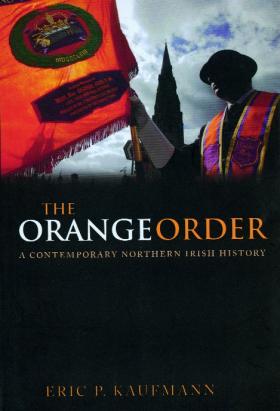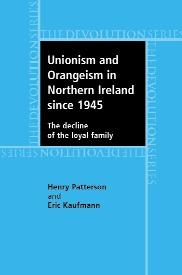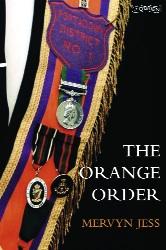The Orange Order
Published in 18th-19th Century Social Perspectives, 18th–19th - Century History, 20th Century Social Perspectives, 20th-century / Contemporary History, Issue 6 (Nov/Dec 2007), Reviews, Volume 15
The Orange Order
Mervyn Jess
(O’Brien Press, €11.95)
ISBN 97808627896619
The Orange Order: a contemporary Northern Irish history
Eric P. Kaufmann
(Oxford University Press, £30)
ISBN 9780199208487
Unionism and Orangeism in Northern Ireland since 1945: the decline of the loyal family
Henry Patterson and Eric Kaufmann
(Manchester University Press, £16.99)
ISBN 9780719077449
Orangeism, once the subject of almost universal bewilderment, derision and contempt, has recently become interesting to historians, sociologists, anthropologists and political scientists as well as journalists. As a secretive fraternity embodying and reproducing the allegiances and ideals of sectarian Protestantism, its influence in shaping Irish and Ulster ‘loyalism’ and unionism has long been acknowledged as a negative force to be reckoned with. Yet, in the absence of either accessible institutional records or impartial documentation, scholars of liberal disposition felt no obligation to analyse its internal dynamics or external associations, which were taken to be mere variations on a theme of irrational bigotry engendered by ignorance, fear and greed. Opponents imagined nothing worthy of investigation beneath the froth of anti-papist rhetoric; initiates protected the secrets of the Order from prying eyes. Apart from a succession of histories written by and for brethren, countered by lurid exposures from former members or Catholic polemicists, no serious investigation of modern Irish Orangeism was undertaken until 1999, when Ruth Dudley Edwards produced her strikingly empathetic study The faithful tribe: an intimate portrait of the loyal institutions (Harper Collins).

Though making scant use of documentary sources, this gifted journalist-historian combined sharp observation with skilful interviews to depict a submerged world of God-fearing, humble, decent brethren struggling to keep the modern, secular world at bay through re-enactment of ancient rituals and mantras. She made Orangeism seem interesting for outsiders, unveiling its positive psychological functions in offering solace and comradeship to communities ripped apart by civil war and terrorism after 1969. Though often frustrated by the pig-headedness, naiveté, and ineptitude of the Order’s public spokesmen, she shrewdly writes as if a critical friend and mentor rather than an apologist or an enemy. A similar tone expressing sorrow more than anger, but sharpened by his long experience of infighting within the Grand Lodge and its committees, was adopted by Revd Brian Kennaway in The Orange Order: a tradition betrayed (Methuen, 2006). Readers of these books discovered that Orangeism was far more than a sectarian band of Protestant zealots seeking to exclude, and if possible to dominate, their Catholic neighbours. The traditional rural lodge was a focus for friendship, restrained conviviality, charity, moral education and cultural celebration, expressed through public and private rituals of solidarity that only occasionally strayed into sectarian animosity or violence. The less attractive face of Orangeism was depicted as a typically urban perversion, whereby roughs and toughs abused the traditions of the Order for nefarious purposes. These works had an elegiac tone, noting the qualitative and quantitative decline of Orangeism since the 1960s, and its growing impotence in political, social and religious life. Though thoughtful, well informed and plausible, such works had a serious flaw: lack of verifiable documentation.
This also applies to the slightest of the works under review, a relatively sympathetic portrait, largely based on interviews, by the journalist and broadcaster Mervyn Jess. These interviews offer a wide range of views on the character and effectiveness of contemporary Orangeism, and on its future role in an increasingly plural province with ever-stronger penalties for both the expression and the practice of sectarian separatism. Jess provides a useful forum for the views of the current grand secretary, Drew Nelson, also reproducing an intelligent critique by a rather liberal, anonymous Orangeman frustrated by the Order’s reiterated failure in the ‘propaganda war’. For good measure, Gerry Kelly of Sinn Féin supplies an articulate but conventional denunciation of Orange intolerance and bigotry, while admitting its right to exist as a cultural association. As a source of factual information, however, Jess is highly unreliable. Edward Saunderson was Grand Master of Scotland in the 1880s and of Belfast in 1901–3, but not of Ireland in the 1870s (p. 38); the Black Institution has never been without ‘a political dimension’ (p. 72). Jess relies for his history on interviews with historians, not always experts on Orangeism, embellishing their utterances with sometimes excruciating journalistic conceits such as the following: ‘The Ulster Volunteer Force, which included Ulster Clubs members and Orangemen, donned the khaki uniforms of the British army, packed their Orange collarettes into their knapsacks and marched off to the Somme to die in Flanders’ fields’ (p. 47). Reader, how many errors does that sentence contain?

No current student of Orangeism can legitimately protest that institutional records are withheld by a secretive and defensive organisation, terrified of exposure. Over the past decade, the Grand Orange Lodge of Ireland and many subsidiary bodies have realised that the organisation’s public image is more likely to be enhanced than damaged by the selective release of confidential printed reports, minute books and even office correspondence. Like their Masonic counterparts a few years before, Orange organisers calculated that few really damaging revelations would result from academic perusal of the available documents, and that the practice of transparency would encourage public trust in the institution as well as state subsidies for its ‘cultural’ enterprises. The remaining works under review have put this policy of enlightened self-interest to the test by making exhaustive use of an impressively wide range of confidential records stretching from 1945 to 2005. Both books emerged from a state-funded research project initiated by Eric Kaufmann, a ruthlessly systematic Canadian political scientist based at Birkbeck College, London, readers being referred to his Orange website for more detailed specification of variables and presentation of statistical data. But for the incentives for multiple publication now imposed by funding agencies and universities, the material for these two heavily overlapping books would presumably have been condensed into a single volume. Both works are primarily concerned with the political influence and machinations of the Grand Lodge of Ireland during the last years of the old Stormont administration and the subsequent decades of turmoil and attempted normalisation.
The Manchester volume, stiffened by the expert collaboration of Henry Patterson at the University of Ulster, covers a longer period and deploys a wider range of sources in order to unravel the connection, now severed, between the Orange Order and the Ulster Unionist Council (UUC) and Party. Newspapers and confidential party records are methodically matched with Orange reports to generate a minutely detailed chronicle of the innumerable conflicts and debates that have tested the efficacy of Orangeism as a lobby within ‘official’ Unionism. For Oxford, Kaufmann has largely ignored the period between 1945 and 1963 and made only perfunctory attempts at documentary contextualisation, instead depicting Unionist politics almost entirely from the perspectives of Grand Lodge and its internal critics. In compensation, he supplies important additional analysis of the workings of Grand Lodge and its committees, and on the changing leadership and composition of the Order. Both books rely mainly on extensive summaries of the inner workings of Orangeism and Unionism, inviting the enthusiast to witness laborious re-enactments of half-forgotten battles over parades, the display of disloyal emblems, intercourse with Roman Catholics, the ecumenical movement, and a succession of ‘power-sharing’ projects and constitutional ‘initiatives’. No confidential detail is spared, the prurient reader being treated to extracts from recent letters of resignation and even a report of the margin by which the current grand secretary defeated the incumbent in 2004 (p. 264). As one who has examined most of the records cited, I can attest to the authors’ accuracy as reporters, though a misleading account is given of the charges that led to the expulsion of Phelim O’Neill MP in 1968 (pp 35–8). There is a cast of hundreds, yet most of the protagonists appear merely as names representing a specified district or county, stripped of biographical background and the personal anecdotes that might have given life to these obscure activists (connoisseurs will easily identify the ‘delegate named Garland’ who denounced O’Neillism before Belfast District Lodge No. 3 in 1969: p. 46). The authors adopt the flat, graceless style now endemic in social science, as if to emphasise their passionless objectivity amidst the emotionally charged whirlpools of Ulster politics. If Edwards and Kennaway made Orangeism seem unexpectedly interesting, Kaufmann and Patterson contrive (on occasion) to make it needlessly boring through over-exposure.
As studies in political science, however, these books present a more persuasive and better-documented analysis of Orange politics than any predecessor. Patterson and Kaufmann show that the revival and continued dominance of official Unionism after the Second World War was largely due to the symbiotic relationship between the Northern government and the Grand Lodge. Though unable to reverse the British-directed tide towards a welfare state and away from Protestant ascendancy, the Order was able somewhat to retard social modernisation and strongly influence the composition of governments in return for mobilising the brethren behind the governing party. Lacking an effective constituency organisation, the Ulster Unionist Party could not hope to activate popular support without vigorous cooperation from the Orange lodges, so amply represented on the UUC. Yet, as a ‘bottom-up’ organisation with a cumbersomely democratic structure, the Orange Order never constituted a solid bloc within Unionism, rather representing a wide range of views and social groups whose internal debates and tensions mirrored those of Unionism in general. Orangeism was at the heart of Unionism, a relationship resembling that between Labour and the British trades unions rather than the more sinister dependence of a populist movement on a tightly organised élite (as with Sinn Féin and the IRA, or the DUP and the Free Presbyterian Church of Ulster).
After the imposition of direct rule in 1972, the Orange Order was rapidly marginalised from the process of formulating government policy, returning to the condition of frustration and virtual impotence which it had endured for most of its history before 1922 (a parallel not noted by Kaufmann or Patterson). Yet it remained a formidable force within Ulster Unionist politics, securing the survival of the UUP and its lingering ascendancy over Paisley’s DUP, and acting as a forum for seeking mutual toleration or even joint action among the many factions of loyalism engendered by the terror. The ugly face of loyalist collaboration was most manifest at and about Drumcree, a futile campaign for which these books supply significant fresh documentation. After 1998, however, the growing gulf between Trimble’s UUP and Orange nay-sayers led to further loss of political sway, as the Order acquiesced in the triumph of its old adversary Paisley and a political party that owed little to the fraternal ecumenism of Orangeism. Powerless to arrest the drift of brethren towards the DUP, the Order was content to seal the destruction of the UUP without aspiring to effective influence over its supplanter. As in the mid-nineteenth century, Orangeism was reduced to a reactionary lobby on the fringes of both Unionist politics and government decision-making.
The major contribution of this project is to provide the first reliable profile of the brethren, based on the annual membership returns for private lodges, the published lists of officers (sorted according to post code) and a long series of nomination forms for Belfast. Lodge returns and county statistics are expertly manipulated to provide an authoritative social and religious geography of ‘Orange density’, demonstrating that Orangemen have consistently clustered in districts with large Catholic populations and with a large Episcopalian element within Protestantism. In recent times, the retraction of Orangeism in urban areas has spread province-wide, and the particular strength of the organisation in rural districts with little in-migration has become more pronounced. Various ingenious indicators of social class are employed to show that the Order, always dominated numerically by what used to be the working classes, has become increasingly ‘democratic’ as the former presiding élites at each level of authority have melted away. The widespread assumption that the Order has failed to attract the burgeoning clerical and professional classes is shown to be correct.
The statistical data are mostly robust, but the resultant inferences are less secure and internally inconsistent. It is surely simplistic to typify rural ‘border’ Protestants as predominantly ‘traditional’ and ‘British’ in their Unionism, by comparison with the more secular ‘Ulster’ ethnicity of Orangemen from Belfast, Antrim and Down. These are implausibly depicted by Kaufmann (pp 12–13) as inheritors of a rebel, dissenting, hard-line tradition whose loyalty to the Crown and the state is more ‘conditional’ than that of their less-militant border counterparts. This specious antithesis is glaringly at odds with that developed in collaboration with Patterson, which counterposes militant, overtly sectarian borderers with more liberal and reformist metropolitan elements of Orangeism centred in Belfast! Nor is it easy to reconcile the relative decline of Orangeism in Belfast and the north-eastern region with the apparent triumph within the Order of the ‘rebel’ tradition allegedly embodied in Paisley’s DUP. As both works infelicitously assert: ‘Unionism’s rebel alter ego has moved into the driver’s seat and the traditionalism of a century is shrinking back into the shadows’ (Kaufmann, p. 235; Kaufmann and Patterson, p. 255). How, moreover, do we reconcile the public love affair between Paisley and McGuinness on the current executive with this hypothesis of an unbroken rebel tradition? Events have already cast doubt on the assumption that today’s DUP is more intransigent or sectarian in practice, as distinct from rhetoric, than Trimble’s UUP, thereby undermining the ‘intimations of a shift to rebel Orangeism’, with possibly catastrophic implications, which Kaufmann infers from changing patterns of party affiliation. In Kaufmann’s mind, fed by survey data and inferences from a dubious interpretation of ‘Paisleyism’, ‘newer generations are if anything more ethnically aware than previous ones’, suggesting an anti-liberal radicalisation of Ulster’s youth comparable to that affecting young Muslims in Palestine (pp 306, 316). Few residents of Northern Ireland, however alert to the horrific and enduring force of sectarian animosities, would accept this proposition. When a political scientist moves from methodical observation to speculation, his views carry the same weight as those of a journalist or a hurler on the ditch.
Like so many ‘contemporary histories’, Kaufmann’s analysis suffers from the absence of an informed historical perspective, despite his useful analysis of membership returns spanning much of the twentieth century. The past is raided for statistical comparisons with the present, rather than being sifted for traces of the origins and development of today’s structures and attitudes. Kaufmann, when writing without the benefit of Patterson’s historical expertise, is particularly ill at ease with the Republic of Ireland (‘Eire’) and religion: few historians would be so crass as to attribute ‘establishment status’ to the long-disestablished Church of Ireland, or to dismiss both Presbyterians and Methodists as ‘low-church dissenting sects’ (p. 11). An Anglican bishop is designated as ‘the Rev. R. Elliott’, while a celebrated adversary of the Orange appears as ‘the Catholic cardinal Cahan Daly’ (pp 30, 175). Kaufmann’s perspective is also distorted by excessive reliance on records of the Grand Lodge, which by his own analysis has never exercised effective discipline or control over dissidents. He therefore exonerates the Order of involvement in paramilitary bodies and terrorism on the basis of repeated denunciations by the leadership (p. 290), without asking awkward questions about the extra-curricular activities of the ‘rank and file’.
The most serious flaw in a project that has generated immensely valuable data, intelligently analysed, is an underlying lack of empathy bordering upon incomprehension. Kaufmann presents himself as an ‘average metropolitan North American or Western European’ who can scarcely grasp the ‘sense of faith, place, and history’ exhibited by one of his informants, Henry Reid from the Clogher Valley (p. 133). Kaufmann’s account of this alien encounter provides almost the only expression in either book of human engagement or curiosity about the psychology of the objects of enquiry. Kaufmann is the cold-blooded investigator from outer space, ransacking the House of Orange for signs that, even there, men are governed by ‘rational choice theory’ while institutions conform to ‘resource mobilization theory’. He struggles manfully to understand why a rationally conducted ethno-cultural organisation proved so much more unsympathetic to ‘power-sharing’ than its resource-pool of Protestant Unionists, limply appealing to the untestable figment of a ‘silent minority’ of ‘pro-power-sharing Orangemen who dared not or cared not to speak their name’ in 1998. He thus fails to grapple with the depth and (in a certain world-view) cogency of sectarianism as a source of group identity (pp 112–14). This points to a deeper and broader absence in both studies, that of a concern with the functions and meanings of Orangeism beyond the constricted domains of politics and administration. At the outset, Kaufmann observes that ‘the Order is an extremely multifaceted organization that must be considered in all its manifestations: cultural, religious, convivial, and political’ (p. 1). Yet his work, while illuminating the recent politics of Orangeism with unprecedented clarity and precision, leaves the soul of Orangeism shrouded in darkness.
David Fitzpatrick is Professor of Modern History at Trinity College, Dublin.
















